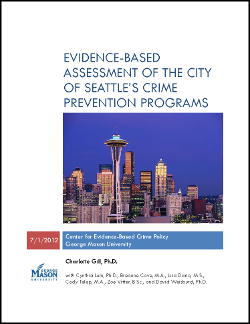
In October 2011, the City of Seattle tasked the Center for Evidence-Based Crime Policy at George Mason University (CEBCP) with conducting an evidence-based assessment of the City of Seattle’s crime prevention programs. Earlier in 2011, the City Budget Office (CBO) developed an inventory of 72 “services that have crime prevention either as a primary purpose or a secondary or indirect purpose,” and a review of both the resources required to run these services and their desired outcomes. In response to that report, the city council requested that the CEBCP conduct a follow-up study that would include a comprehensive review of the crime prevention mechanisms, theoretical bases, and existing evaluative literature underlying the 63 programs in the inventory that were not primarily security-based.
CEBCP researchers assessed the descriptions provided in the CBO report for each of the 63 programs to identify their primary crime prevention mechanisms and theoretical bases, and then compared them against the most rigorous research evidence (studies employing at least quasi-experimental methods involving a comparison group). It is important to note that time and resources did not permit a full systematic literature review of all the available evidence for each program or a full process evaluation of Seattle’s programs beyond the high-level CBO descriptions. Thus, this report does not present a comprehensive assessment of the programs or their evidence base. However, CEBCP drew upon highly-regarded repositories of existing reviews, meta-analyses, and primary research to draw parallels between Seattle's programs and the state of knowledge in crime prevention research more generally.
Researchers concluded that over one-quarter of Seattle’s crime prevention programs have strong to moderate evidence of potential for effectiveness. However, more work is needed to increase the number of programs that replicate or closely resemble existing evidence-based protocols.
The majority (37 programs, 59%) of programs are connected to places and community settings. This is encouraging. Although the evidence-base for community programs is mixed, the general consensus in the field is that communities are a promising target for prevention (Sherman et al., 2006). Lipsey (1992) also notes that treatment in community settings works well, especially for juveniles. Community-based prevention has the potential to be particularly effective in Seattle, given the city's strong tradition of community organizing.
Many of Seattle’s programs serve young people. Early intervention is one of the key principles of effective crime prevention programming (e.g. Piquero et al., 2008).
